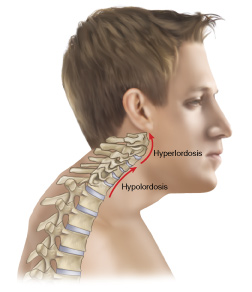Signs and Symptoms of Slumped Spinal Posture
The most obvious sign of slumped spinal posture is the characteristic slumped postural dysfunction from the pelvis to the head.

Slumped spinal posture rounds the thoracic spine into hyperkyphosis and the head into forward carriage. Permission: Joseph E. Muscolino.
Upon palpation, the following muscles will most likely be found to be short and tight (locked short): hamstrings, anterior abdominal wall muscles, neck flexors (especially the sternocleidomastoid), head extensors and protractors (especially the suboccipital muscles), protractors of the scapula (pectoralis muscles) and medial (internal) rotators of the humerus. The following muscles will most likely be found to be long and tight (locked long): paraspinals (erector spinae and transversospinalis) of the trunk, neck extensors, retractors of the scapula, and lateral (external) rotators of the humerus.
And the client/patient will feel restriction of the following motions: anterior tilt of the pelvis, extension of the lumbar, thoracic, and lower cervical spine, flexion of the upper cervical spine and retraction of the head, scapular retraction and lateral rotation of the arms.
Although pain is not necessarily a part of this condition, when this condition has existed for a long time, the client/patient does often experience upper back and neck pain, both due to the global tightness of and myofascial TrPs in these muscles as they fight gravity to prevent the upper back and neck from falling even further into flexion. Hamstring tightness will often lead to spasms and local pain, as well as possible restriction of movement of and discomfort and pain in the sacroiliac joints. Chronic thoracic flexion with protracted scapulae and medially rotated humeri often lead to an inability to take in a deep breathe as well as an increased likelihood of shoulder (glenohumeral) joint problems (rotator cuff impingement).
Assessment/Diagnosis of Slumped Spinal Posture
Assessment/diagnosis of slumped spinal posture is made upon static postural examination (from a lateral view). In fact, this condition is usually fairly obvious when observing the client/patient during the verbal history. Upon palpatory examination, tightness and the likely presence of myofascial TrPs will be found in all of the overly facilitated (tight) muscles listed above. And verbal history will likely reveal habitual slumped seated posture.
Slumped spinal posture is a dysfunctional postural condition (postural distortion pattern) of the musculoskeletal system, so no further medical diagnosis/assessment is needed. However, if X-Rays are done, not only will the altered posture of the spine be easily visualized on the lateral view, but the anterior wedging of the lumbar vertebral bodies might also be visible in clients/patients who have had this condition for many years.
Differential Assessment of Slumped Spinal Posture
Assessment of slumped spinal posture is straightforward and simple; therefore no differential assessment is necessary. If the client/patient has the characteristic slumped posture, this condition can be assessed with confidence. However, this does not mean that the client/patient does not have the presence of additional conditions that should be assessed. The presence of any musculoskeletal condition as pervasive as this one can have widespread effects. Look especially for upper trunk, neck, head, shoulder girdle, and arm conditions. Thoracic outlet syndromes, glenohumeral joint impingements, and headaches are especially common.
(Click here for a blog post article on the causes of slumped spinal posture.)

